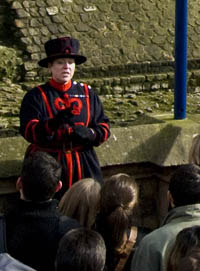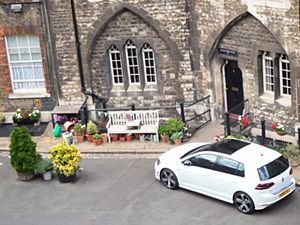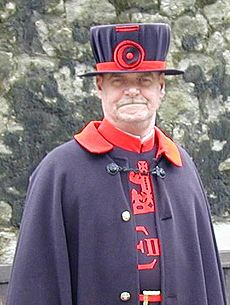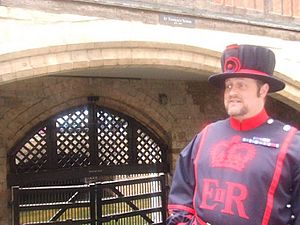Yeomen Warders facts for kids
Quick facts for kids Yeomen Warders of His Majesty's Royal Palace and Fortress The Tower of London |
|
|---|---|
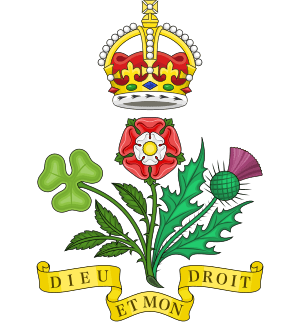
Badge of the Yeomen Warders
|
|
| Active | 1485 (1509: see History) – present |
| Country | United Kingdom |
| Role | Palace and Fortress Guard |
| Garrison/HQ | London |
| Motto(s) | Dieu et mon droit |
| Commanders | |
| Colonel in Chief | The King |
| Insignia | |
| Collar Badge | Rose, Thistle and Shamrock |
The Yeomen Warders are special guards at the Tower of London. Most people know them by their nickname, the Beefeaters. Their main jobs are to look after the Tower and protect the amazing Crown Jewels. They also give fun guided tours to visitors, a tradition that started a long time ago in the Victorian era.
All Yeomen Warders have served in the British Armed Forces. They must have been a high-ranking officer (called a warrant officer). They also need at least 22 years of service. Plus, they must have earned a special medal for long and good service. There are currently 32 Yeomen Warders and one Chief Warder.
Even though they are often called "Yeomen of the Guard," the Yeomen Warders are actually a separate group. The Yeomen of the Guard are another group of royal bodyguards for the British monarch.
Contents
Why are they called Beefeaters?
The nickname Beefeater has a bit of a mystery around it. No one is completely sure where it came from. The word was used in the 1600s as a slang term for English people.
The first time it was linked to the Royal Household was in 1669. A visitor from Italy, Cosimo III de' Medici, Grand Duke of Tuscany, saw the Yeomen of the Guard. He wrote that they were given "a very large ration of beef daily." He thought they could be called "Beef-eaters."
This nickname then moved to the Yeomen Warders. This happened because the two groups looked similar. Also, the Yeomen Warders were seen by the public more often. Another idea is that Beefeaters made and ate thick beef broths. These broths were known as bef or beffy at the time.
Some people think the name comes from an old French word, buffetier. This word meant a servant who waited at a table. But experts say there is no real proof for this idea.
History of the Yeomen Warders
How the Tudor Yeomen started
The Yeomen Warders were created in 1485 by King Henry VII. He was the first king of the Tudor dynasty. You can still see the Tudor rose, a symbol of his family, on the Yeomen Warders' badge today. This group was formed after a big battle called the Battle of Bosworth. It is the oldest military group in the UK that is still active today. It is also the oldest of the royal bodyguards.
In 1509, King Henry VIII moved his main home away from the Tower of London. But the Tower was still an important royal palace. To show this, a small group of twelve Yeomen of the Guard stayed there. They became known as Tower Warders. This name showed their new job of guarding the Tower.
At first, they lost the right to wear the fancy red uniform of the Yeomen of the Guard. But King Edward VI (who ruled from 1547 to 1553) gave them back their red uniforms. This happened after a high-ranking official was briefly held in the Tower. He was very impressed by how the warders behaved.
The original Tudor guard had two types of members. There were the "ordinary" (permanent) guards and "extraordinary" (additional) troops. In 1551, the number of ordinary guards grew to 200 men. They wore velvet coats decorated with silver, over their armor.
The Yeomen Warders were the Tower's main guards. But the Constable of the Tower could ask for help from local men if needed. These men lived in an area called the Tower Hamlets. They had a duty to help guard the Tower when asked.
What they do today
In 2018, there were 37 Yeomen Warders and one Chief Warder. In the past, they were mainly guards. But now, their job is mostly ceremonial. They welcome visitors and give tours. This is part of their 21 different duties.
All Yeomen Warders are retired members of the armed services. To become a Warder, you must be a high-ranking officer (like a Warrant Officer Class 1 or 2). You can be from the Royal Navy, British Army, Royal Air Force, or Royal Marines. You must also have earned a special medal for long and good service. And you need to have served for 22 years in the military.
Before 2009, sailors could not become Yeomen Warders. This was because sailors swore loyalty to the British Admiralty, not directly to the monarch. But in 2009, Queen Elizabeth II allowed Royal Navy sailors to join.
Yeomen Warders and their families live in homes inside the Tower fortress. They pay rent and taxes like anyone else. Most also have a home outside the Tower. This gives them a break from their work environment. There is even a special pub inside the Tower just for the Warders and their guests. When they retire, they must move out of the Tower. Some of their homes are very old, dating back to the 1200s. The Tower of London is a small community. It includes the Warders and their families, the Governor, officers, a chaplain, and a doctor.
Every night, the Yeomen Warders take part in the Ceremony of the Keys. This is a very old tradition where the Tower is locked up for the night.
On July 1, 2007, Moira Cameron became the first female Yeoman Warder.
In December 2018, the Yeomen Warders went on strike for a few hours. This was to protest changes to their pension plan. It was their first strike since 1963.
In July 2020, the charity that runs the Tower of London, Historic Royal Palaces, faced money problems. This was because of the COVID-19 lockdown. For the first time ever, some Yeomen Warders were at risk of losing their jobs. Luckily, no one was forced to leave. But five warders chose to take voluntary redundancy.
As of July 2023, the Chief Yeoman Warder is Rob Fuller. The Yeoman Gaoler, who is second-in-command, is Clive Towell.
Uniforms
The Yeomen Warders usually wear a dark blue uniform with red trim. This is their everyday uniform. For senior warders, the red collar and cuffs have gold braid. When the King or Queen visits the Tower, or for special state events, they wear a fancy red and gold uniform. This uniform is very similar to what the Yeomen of the Guard wear. The Yeoman Warders call this their Tudor State Dress.
How Yeoman Warders are different from Yeomen of the Guard
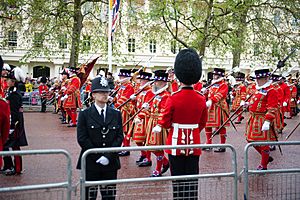
People often mix up the Yeomen Warders with the Yeomen of the Guard. The Yeomen of the Guard are the original "Beefeaters." They are a similar but separate group. For special events, the Yeoman Warders wear the Yeomen of the Guard's unique uniform. This uniform is a royal red tunic with purple and gold decorations. It includes red knee-breeches, red stockings, a flat hat, and black shoes with colorful rosettes.
The gold designs on the front and back of the coats are very special. They include the crowned Tudor Rose, the shamrock, and the thistle. These are symbols of England, Ireland, and Scotland. The uniform also has the motto Dieu et mon droit (which means "God and my right"). It also shows the royal cypher (a special symbol) of the current King or Queen. The State Dress is often worn without a ruff (a pleated collar). The ruff is saved for very important official events.
One part of the uniform helps tell the two groups apart. The Yeomen of the Guard wear a red cross-belt over their left shoulder. This belt is a reminder of when they carried a type of gun called a harquebus. Oddly, the Yeoman Warders also have a black shoulder strap on their back. This was originally meant to hold the harquebus bandolier (a belt for bullets) in place.
Ranks and Badges
| Rank | Insignia |
|---|---|
| Chief Yeoman Warder | Four gold chevrons and a gold crown above. On the chevrons, a pair of crossed gold keys bordered in red, the key bits pointing down |
| Yeoman Gaoler | Four gold chevrons and a gold crown above. A gold miniature of the Norman White Tower on the chevrons |
| Yeoman Clerk | Four gold chevrons and a gold crown above |
| Yeoman Warder Serjeant | Four gold chevrons |
| Yeoman Warder Ravenmaster | (no rank but appointment) Red circular cloth badge, with a black raven head protruding from three gold merlons, the badge's lower half surrounded by a gold laurel wreath |
| Yeoman Warder | No insignia |
The rank badges (chevrons) point down and are worn on the right upper arm. The Ravenmaster's special badge is worn on the right lower arm. When wearing their State dress, the Chief Yeoman Warder carries a black cane. For very special occasions, he carries a ceremonial staff with a tiny White Tower on top.
The Yeoman Gaoler is the Chief Yeoman Warder's second-in-command. In State dress, he carries a Dane axe. This is a long battle-axe that came from the Vikings. All other Yeoman Warders in State dress carry swords. The ordinary Warders and Serjeants also carry long spears called partisans.
The Ravenmaster
The Yeoman Warder Ravenmaster is a special job, not a rank. This Warder is in charge of looking after the ravens at the Tower of London. This official title has been used since the 1960s.
No one knows exactly how long ravens have lived at the Tower. But they were definitely there by the time of King Charles II. A famous legend says that if the ravens ever leave the Tower, the White Tower will fall. This would bring disaster to the kingdom.
King Charles II once wanted to get rid of the ravens because they bothered his astronomer. But when he was reminded of the legend, he decided to move the Royal Observatory instead! He ordered that at least six ravens must always stay at the Tower. It's thought that keeping ravens captive only started in the late 1800s.
As of 2018, the Ravenmaster was Christopher Skaife. He is a retired military officer and has written a book about his experiences.
To stop the ravens from flying away, their flight feathers are usually trimmed. This means they can't fly in a straight line for very far. But the ravens are free to walk around the Tower grounds. Recently, the Ravenmaster has been trimming less of their wings. This lets them fly more, instead of just hopping or gliding. They can even reach the tops of buildings. One raven, Merlina, was allowed to fly to the nearby river wharf. But she always came back because she was bonded with her keeper.
The Ravenmaster lets the birds out of their cages and prepares their breakfast every morning. The warders joke that the "real beefeaters" at the Tower are the ravens! Traditionally, they ate raw beef bought from Smithfield Meat Market. Now, they also eat other foods like chicks, lamb, mice, and pig hearts. They also get peanuts and dog biscuits soaked in blood and fish. This helps stop them from looking for food in the rubbish bins.
Opera
The Tower Warders are part of a famous 1888 opera called The Yeomen of the Guard. It was written by Gilbert and Sullivan. The story takes place in the Tower of London in the 1500s. It is about the group that later became the Yeomen Warders.
See also
- Corbet family
- Cultural depictions of ravens
- Gens Valeria
- Londinium
- Marcus Valerius Messalla Corvinus
- Marcus Valerius Corvus


